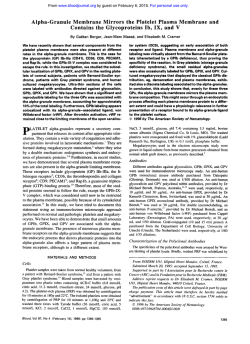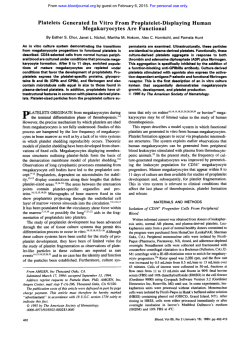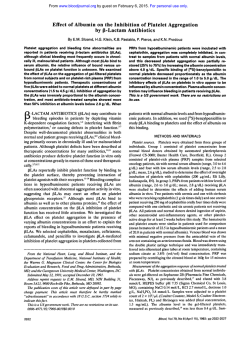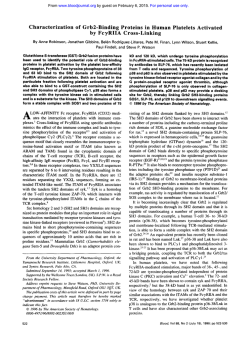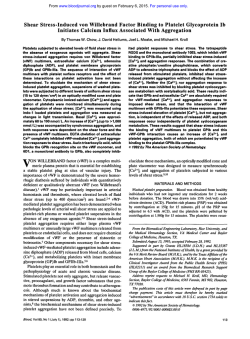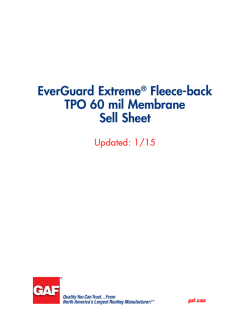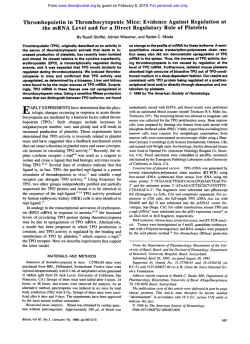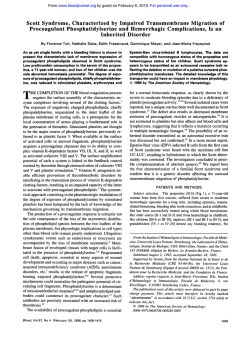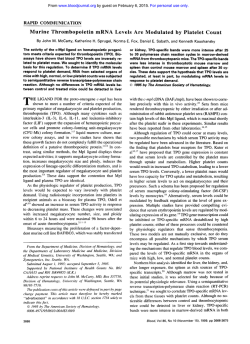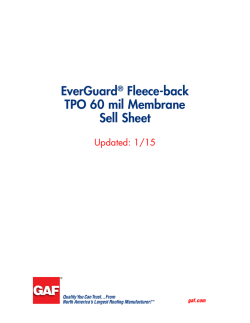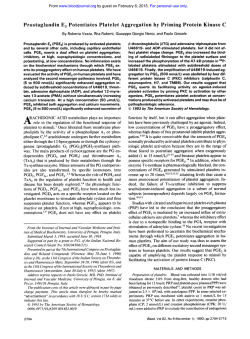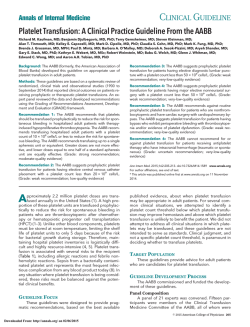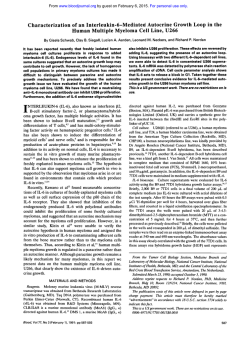
Relative Reactivity of Platelets From Thrombopoietin- and
From www.bloodjournal.org by guest on February 6, 2015. For personal use only. Relative Reactivity of Platelets From Thrombopoietin- and Interleukin-6 - Treated Dogs By Jinpeng Peng, Paul Friese, Roman F. Wolf, Paul Harrison, Tamyra Downs, Si Lok, George L. Dale, and Samuel A. Burstein Previous reports have shown that interleukin-6 (IL-6) enhances the responsivenessof platelets to thrombin stimulation and has modest thrombocytopoietic effects in vivo. Thrombopoietin 1TPO; mpl ligand) has been shown t o have dramatic thrombocytopoietic effects in vivo, but little is known of its capacity t o alter platelet function. In this study, a direct comparison of the effects of IL-6 and TPO on platelet function in dogs has been performed, with modest doses of TPO (1pg/kg/d) chosen t o match or moderately exceed the platelet counts achieved with IL-6 (40pg/kg/d) for 10 days. Platelet responsiveness to thrombin stimulation was assessed in TPO-treated, IL-6-treated, and control dogs by flow cytometric measurement of P-selectin expression. On day 5, the dose of thrombin promoting half maximal stimulation (E&) of platelets was not significantly changed in TPOtreated dogs, whereas in IL-6-treated dogs the ECm decreased t o 73.1% 2 6.1% (mean l SD; n = 5) of control values ( P c 0.01). These experiments were performed on both gel-filtered platelets and washed whole blood, indicat- ing that the observed changes in E& were caused by cytokine-mediated alteration of platelets rather than plasma components. Because it has been shown that thiazole orange specifically labels a subpopulation of dog platelets that is less than 24 hours old, the thrombin responsiveness of these young, newly synthesized platelets was determined. The ECso of thiazole orange-positive platelets from IL-6treated dogs decreased dramatically by day 5 to 46.5% & 13.1% (n = 4) of control values 1P < 0.001), whereas TPOtreated dogs did not significantly change. When TPO was directly incubatedwith platelets ex vivo, no effects on either thrombin-mediated P-selectin expression or adenosine diphosphate-induced fibrinogen binding were observed. These data show that IL-6 alters platelet function, as measured by reactivity t o thrombin, whereas TPO does not. This divergence in function is observed even though TPO is equally, or more, effective at promoting platelet production under these experimental conditions. 0 1996 by The American Society of Hematology. I approach in experimental animals to transiently increase the number of young platelets in the circulation. Furthermore, we have recently described a method to identify platelets less than 24 hours old in the dog.” With these developments, it is now feasible to directly compare the effects of IL-6 and TPO on platelet reactivity and to ascertain if the IL-6mediated alterations in platelet function previously described’ reflect only an increase in young platelets or perhaps an alteration in platelet reactivity. * NTERLEUKIN-6 (IL-6), a cytokine with numerous biological consequences,’ shows a variety of effects on the hemostatic mechanism, including inducing a modest elevation in the platelet count in normal and thrombocytopenic animals as well as in human^,"^ an augmentation of plasma fibrin~gen,~ and an enhancement of platelet size and platelet f~nction.6.~ These alterations of platelet function may originate at the level of the megakaryocyte, because direct incubation of canine platelets with IL-6 has no effect on the activation capacity of platelets in response to t h r ~ m b i nSince . ~ IL6 increases the platelet production rate,8 it is conceivable that the observed changes in platelet function reflect an increase in young, more hemostatically effective platelets, rather than a specific alteration caused by the cytokine.’ The recently described growth factor thrombopoietin (TPO; mpl ligand), has been shown to have very potent thrombopoietic effects in mice, but little is known about its influence on platelet function.1°-16 Because the elevation in platelet count caused by TPO is almost certainly a result of increased production, the hormone provides an alternative From the Department of Medicine and the W. K. Warren Medical Research Institute, University of Oklahoma Health Sciences Center, Oklahoma City, OK: and the Zymogenetics Corp, Seattle, WA. Submitted May 1, 1995; accepted October 27, 1995. Supported by the W.K. Warren Medical Research Institute, an award from the American Heart Association (Oklahoma Affiliate), and Grants No. HL50059 and AGO8545 from the National Institutes of Health. Address reprint requests to Samuel A. Burstein, MD, University of Oklahoma Health Sciences Center, Room 271, College of Health Bldg, PO Box 26901, Oklahoma City, OK 73190. The publication costs of this article were defrayed in part by page charge payment. This article must therefore be hereby marked “advertisement” in accordance with 18 U.S.C. section 1734 solely to indicate this fact. 0 1996 by The American Society of Hematology. 0006-4971/96/87I0-0060$3.00/0 4158 MATERIALS AND METHODS Materials. Bovine thrombin, prostaglandin E, (PGE,), and bovine serum albumin (BSA) were obtained from Sigma Chemical Co (St Louis, MO). Fluorescein isothiocyanate (FITC) and phycoerythrin-labeled streptavidin (streptavidin-PE) were obtained from Calbiochem (La Jolla, CA). NHS-biotin was obtained from Pierce Chemical Co (Rockford, IL). Caltag Laboratories (South San Francisco, CA) provided the streptavidin-TRI-COLOR, and rabbit antihuman fibrinogen was from Dako Laboratories (Carpinteria, CA). Thiazole orange (TO) was supplied as Retic-COUNT Kit from Becton Dickinson (San Jose, CA). Formalin was obtained from Fisher Scientific (Fairlawn, NJ). Bujfers. The buffers used were as follows: BSGC, pH 7.3 (buffered saline-glucose-citrate: 129 mmol/L NaCl, 13.6 mmol/L Na? citrate, 11.1 mmol/L glucose, 1.6 mmol/L KHZP04,8.6 m m o w NaH,PO, [pH, 7.31; ACD (acid citrate dextrose: 38.1 mmom citric acid, 74.8 mmol/L Na7citrate, 136 mmol/L glucose); and PBS (phosphate buffered saline: 150 mmol/L NaCI, 10 mmol/L NaH,P04 [pH, 7.41). Cytokines. Recombinant human IL-6 was expressed in Eschericheria coli and purified as previously described.6Concentration and purity were assessed by the IL-6-responsive B9 cell bioassay’’ and sodium dodecyl sulfate-polyacrylamide gel electrophoresis. Endotoxin levels were measured using the limulus amebocyte lysate test at Endosafe Inc (Charleston, SC). The specific activity of the purified product was 2 to 5 x IOs U/mg protein and had an endotoxin level of less than 2 U/mg. Recombinant human TPO (0.1 19 mglmL in 20 mmol/L Tris, 0.15 mol/L NaCl [pH, 8.51) was provided by Dr D. Foster (Zymogenetics, Seattle, WA). Blood, Vol 87, No 10 (May 15), 1996 pp 4158-4163 From www.bloodjournal.org by guest on February 6, 2015. For personal use only. 41 59 REACTIVITY OF CYTOKINE-DRIVEN PLATELETS Monoclonal antibodies (MoAbs). To detect canine platelets in whole blood, antibody 2F9, recognizing a component of the glycoprotein IIbDIIa complex, was used as described.” To detect activated canine platelets, antibody G5 (subtype IgGI; cell line provided by R. McEver, Oklahoma Medical Research Foundation, Oklahoma City, OK) raised against human P-selectin and cross-reacting with the canine counterpart, was used. 2F9 was directly fluoresceinated with FITC and G5 was biotinylated with NHS-biotin using standard techniques. Biotinylated Tab (provided by R. McEver; an IgG, MoAb recognizing human but not dog platelets) was used as an isotype-specific control to set gates for resting versus activated platelets. MoAbs to detect canine fibrinogen were produced by immunizing BalblC mice with purified dog fibrinogen.” Antigen was injected bimonthly 3 times into multiple subcutaneous and intraperitoneal sites of Balb/C mice. Serum antifibrinogen titers were determined by enzyme-linked immunosorbent assay (ELISA). Four days after a final injection was administered intravenously, the mice were killed, and the spleen cells were fused in 50% polyethylene glycol-1500 (Sigma) at pH 7.0 to Sp2/0 murine myeloma cells according to standard techniques.” Hybrids were identified after hypoxanthine, aminopterin, and thymidine (HAT) selection, expanded, and assayed for antifibrinogen antibody by ELISA. Positive clones were subcloned twice from single cells by limiting dilution. One hybridoma, designated 2B11, was used in these studies. Animals. Beagles (8 to 13 kg; Hazleton Research Products, Cumberland, VA) were obtained and housed according to the regulations of the Institutional Animal Care and Use Committee (IACUC) of the University of Oklahoma Health Sciences Center (Oklahoma City, OK; accredited by the American Association for Accreditation of Laboratory Animal Care). In vivo protocol. Blood samples for baseline determinations were drawn followed by administration of TPO (diluted in 0.15 mol/ L NaCl supplemented with 5% autologous dog plasma) at 1 pg/kg/ d or IL-6 at 40 pg/kg/d in the same diluent buffer, both in a single subcutaneous dose for 10 days (days 0 through 9). Control animals received the diluent buffer on the same schedule.6 Blood samples for analysis of cell counts, fibrinogen assay, quantitation of TO+ platelets, and platelet activation were drawn 2 to 3 times weekly. Geljiltration ofplatelets. Gel filtration was used to deplete platelets of plasma components. For thrombin dose-response studies, 5 mL of blood was drawn into 1/10 vol ACD-A with prostaglandin El (final concentration in blood, 0.5 pmom); for fibrinogen binding analysis, blood was drawn into 1/10 vol 3.8% sodium citrate. Blood was mixed with 5 mL of BSGC (pH, 7.3) and centrifuged at 200g for 10 minutes to prepare platelet-rich plasma. Platelet-rich plasma (1 mL) was passed through a 20 mL Sepharose 4B column equilibrated with BSGC (pH, 7.3), and the fraction containing platelets was collected. Platelets were counted on a Baker System 9000 cell counter and adjusted to 50,000/pL with BSGC. Assessment of platelet activation in response to thrombin. Platelet activation was assessed in washed whole blood as previously d e ~ c r i b e dor ~ ,by ~ the following adaptation of those methods. A total of 20 pL of gel-filtered platelets was added to each of seven 15mL polypropylene tubes containing 928 pL of BSGC (pH, 7.3) supplemented with 2 pL of G5-biotin (1 mg/mL) and 50 pL of various concentrations of diluted bovine thrombin in BSGC (pH, 7.3). The tubes were incubated in a 37°C water bath for 10 minutes, followed by the addition of 1 mL of 0.6% formaldehyde in PBS. The tubes were then incubated at room temperature (RT) for 20 minutes, followed by the addition of 10 mL BSGC (pH, 7.3) supplemented with 0.1% BSA and 2 mmoVL EDTA (BSGC-BSA), and centrifuged at 1,250g for 18 minutes at RT to remove the fixative. Pelleted cells were resuspended in 0.4 mL of BSGC (pH 7.3). A total of 200 pL of the resuspended cells was transferred to another tube, followed by the addition of 2 pg streptavidin-PE and 2 pg of FITC-2F9. After incubation at RT for 30 minutes, samples were washed with BSGC-BSA as described above. After resuspension in 0.5 mL BSGC-BSA, samples were analyzed by flow cytometry. Assessment of activation of TO+platelets in response to thrombin. To determine the thrombin-responsiveness of a subpopulation of platelets less than 24 hours old,17 thrombin dose-response curves were performed on gel-filtered platelets as detailed above, and the platelets were then labeled with the RNA-binding dye, TO. Specifically, after the thrombin activation, formalin-fixation, and wash steps described above, 200 pL of sample were incubated with 4 pL streptavidin-TRI-COLOR for 30 minutes at RT to label the biotinylatedG5 antibody. After incubation with 1 mL TO solution for 30 minutes at RT, samples were analyzed by flow cytometry as described below. Streptavidin-TRI-COLOR was used in these experiments, because its emission spectrum does not overlap significantly with that of ~0.17 Adenosine diphosphate (ADP)-induced jibrinogen binding. Fibrinogen binding to activated platelets was performed according to a modification of the method of Warkentin et aLZ2A total of 400 pL of gel filtered dog platelets was mixed with 0.2 mL of citrated dog plasma and 1.2 mL of HEPES buffer (10 mmol/L HEPES, 145 mmoVL NaCI, 5 mmom KCI, 1 mmom MgSO, [pH, 7.41). A total of 180 pL of the mixture was added to each of seven wells of a 96well plate, followed by the addition of 20 pL of various concentrations of ADP (final concentration, mol/L to lo-, mom), and was incubated for 40 seconds at RT. Next, 100 pL of the reaction mix were transferred to tubes containing 2 mL of 0.3% formaldehyde in PBS and fixed for 20 minutes. A total of 10 mL of BSGC-BSA was then added, and the tubes were centrifuged at 1,250g for 18 minutes. The pellets were resuspended in 0.2 mL of BSGC. A total of 5 pg of FITC-conjugated chicken antidog fibrinogen9was added to each tube and allowed to incubate at RT for 30 minutes with occasional agitation, followed by washing in BSGC-BSA. The pellets were resuspended in 0.5 mL of BSGC, and the samples were analyzed by flow cytometry (settings: forward scatter [FSC], log EOO; side scatter [SSC], log 332; fluorescence 1 [FLI], log 520; FSC threshold, 260). In some experiments, gel-filtered platelets were first incubated with 100 ng/mL of active TPO or 100 ng/mL of heatinactivated TPO (100°C for 5 minutes) for 45 minutes at RT before the ADP-induced fibrinogen-binding study. Flow cytometry. The percentage of platelets activated at the various concentrations of thrombin was determined with a FACScan flow cytometer (Becton Dickinson) according to previously described method^.^.^ A total of 10,OOO events were analyzed for Pselectin expression. For analysis of the thrombin dose-response characteristics of TO’ platelets, the flow cytometer was set as follows: FSC, log Em; SSC, log 350; FLl, log 700; and FL3, log 500. A total of 50,000 total platelets were analyzed, and the percentage of TO’ platelets within the activated ((359 and nonactivated populations was determined. ELISA for dogjbrinogen. Dog plasma fibrinogen was measured by ELISA. Briefly, 96-well microtiter plates were coated with rabbit antihuman fibrinogen IgG at a dilution of 1:1,000 in carbonate buffer (pH, 9.6). After blocking, diluted samples and standards were applied to washed plates and bound fibrinogen was detected with biotinylated MoAb 2Bll (diluted 1:200) raised against dog fibrinogen. Bound antibody was detected by incubation with streptavidin-peroxidase. The plates were developed by addition of o-phenylenediamine dihydrochloride/H20, and the absorbance at 492 mp (OD492)measured after the reaction was stopped with 1 m o m H,S04. Statistical analysis. The statistical significance of differences in means was tested with a two-tailed Student’s t-test. RESULTS Platelet counts. To compare platelet function under circumstances in which platelet counts were not drastically From www.bloodjournal.org by guest on February 6, 2015. For personal use only. 4160 = PENG ET AL 1 600 . $ E 500 X Y I c 2 400 0 -0 w Q) 5 300 ti: 200 ~~~~~”’,~”””:”~ 0 2 4-5 8-9 I I I 11-13 1516 21-23 Time (days) Fig 1. Peripheral blood platelet counts ( x 10-’/mL) after administration of IL-6 (A), TPO (MI, snd buffer (0).Platelet counts are shown on the ordinate (mean f 1 SEI; time (days)after initiation of cytokines is shown on the abscissa. IL-6, TPO, and buffer were administared from day 0 through 9 as indicated by the hatched bar (m). For all time points, n = 5 except for days 4 to 5 where n = 4. different between treatment groups, a dose of TPO was used to promote elevations in platelet counts that would approximate or modestly exceed that expected with IL-6 (Fig 1). After the administration of TPO (1 pgikg/d) or IL-6 (40 pg/ kg/d), platelet counts were monitored several times per week. For TPO-treated animals, a maximal increase of 115% above the pretreatment count was observed on days 11 to 13, whereas an increase of 72% above the pretreatment count occurred in IL-6-treated dogs at this same time. Although the increment in platelet count for the IL-6-treated dogs was less than that observed with TPO, the difference was not statistically significant ( P = .09). In vitro responsiveness of platelets to thrombin stimulation. At various times during the course of cytokine administration, platelet responsiveness to graded doses of thrombin was determined by flow cytometry; results are reported as a thrombin ECsO,the effector concentration (EC) resulting in 50% a~tivation.~.’ A summary of these EC50 values from five separate sets of animals is presented in Fig 2. As early as day 2, a decrease in the EC5,, for thrombin in IL-6-treated dogs was observed, although the decrease was not statistically significant until day 5 when the EC50 had dropped to 73.1% t- 6.1% (mean t- 1 SD; n = 5 ) of control ( P < .01). By day 15, the thrombin ECsohad returned to normal in the IL-6-treated animals; IL-6 administration was stopped on day 9. In contrast, there was no significant difference in the EC5o for thrombin between TPO-treated and control dogs at any time point. These data indicate that less thrombin is required to activate the platelets from IL-6-treated animals when compared with that for either TPO-treated or control animals. It is noteworthy that the change in ECso in IL-6treated animals first occurred at day 5 when platelet counts for IL-6 and TPO animals were essentially identical (Fig 1) and before these platelet counts were significantly elevated above control levels ( P > .12). IL-6 markedly augments plasma fibrinogen that might compete for thrombin and alter the thrombin dose-response curve in an unpredictable fashion. In contrast, TPO does not affect fibrinogen concentrations (mean, 1.28 ? 0.06 mg/mL; range, 1.03 to 1.57 mg/nL throughout the treatment course; n = 4). All of the experiments shown in Fig 2 were performed with plasma-depleted platelets, either by washing whole blood (one experiment) or by gel filtration (four experiments). No differences were noted with the two techniques. For example, in Fig 2, the IL-6-treated animals at day 5 had a mean change in thrombin EC50to 73.1% t- 6.1% of control values when all samples were analyzed; if only the gel filtered samples are considered, the change was 74.9% 2 5.4%. Cytokine-induced production of TO+ platelets. Previous studies have shown that TO’ platelets in the dog are less than 24 hours old.17 Before treatment, the mean percentage of TO+ platelets in all animals was 6.5% ? 0.8% (n = 15), and Fig 3A shows the percentage of TO+ platelets during cytokine administration. By day 3 to 4,a slight increase in TO+ platelets was observed in both the TPO- and IL-6treated dogs followed by a modest decrease after cessation of the cytokine, although none of the changes were statistically significant. Figure 3B shows the absolute levels of TO’ platelets during cytokine administration. TPO resulted in statistically significant elevations in TO+ platelet count on days 5: Ye .a 100 E 2 ee! 80 Q s 0 3 6 9 I I 12 15 Time (days) Fig 2. Alterations of the activation capacity of platelets derived from five sets of dogs treated with 11-6 (A),TPO (MI, or buffer (0). For each time point, the thrombin El& WM determined and normalized to the pretreatment E L ; the ordinate show the percantaw of the pretreatment E C , (mean k 1 SE; n = 5). Time (days)after initiation of 11-6 and TPO is shown on the abscissa; cytokinw were administered through day 9, es indicated by the hatched bar ( 0 ) .For the IL-6-treated dogs, a significant decrease in thrombin El& was observed on deys 5 and 8 ( P < .01; noted by asterisk [*I). Startlng ECm values for these three experimental groups were 44.6 k 7.4, 54.4 k 10.1, and 46.2 f 13.0 mU thrombinlmL (mean f 1 SD; n = 5 ) for control, TPO, and 11-6 groups, respectively. From www.bloodjournal.org by guest on February 6, 2015. For personal use only. 4161 REACTIVITY OF CYTOKINE-DRIVEN PLATELETS 45 - c ' B T 40- '90 .- 3 5 - B a, 5 -a, c . (II h 3 - 30- 5 a 25- Q) .-P .e Q) v) * .1 .r 0 4 20 - v) 6 15- 0 3 56 9 12 >15 Time (days) 1 I //////////////// / I I I 0 3 I 5 - 6 1 I I 9 12 4 5 Time (days) Fig 3. Changes in TO+ platelets after IL-6 (AI, TPO (HI, and buffer (0)administration. (A) The percentage of TO* platelets in the peripheral circulation (percentage 2 1 SE; n = 5) is plotted versus the time (days) after initiation of the cytokines 1B). None of the differences h e e n groups are statistically significant. (BI The absoluta levels of TO+ platelets during the experiment is shown. These velues were calculated from the percentage of TO+ platelets and the total platelet count. For TPO, there was a significant elevation in TO+ platelets as compared with For IL-6, the elevation in absolute TO+ counts we. significantly above control only for day control values on days 5 to 6,9, and 12 ( P < .M). 9 ( P < .MI. The difference between TPO and IL-6 was significant only for day 12 ( P < .05). 5 to 6, 9, and 12 after initiation of the cytokine (P < .05); IL-6 also produced increases in TO' platelet counts, although only the day-9 value is significantly different from control values. It is noteworthy that the increases in both the percentage of TO+ platelets (Fig 3A), and the absolute numbers of TO' platelets (Fig 3B) do not correlate well with the increase in total platelets (Fig 1). Considering the dramatic increase in total platelet count elicited by these cytokines, large increases in the percentage of TO' platelets, in particular, would be e x p e ~ t e d . *The ~ * ~reason for this apparent discrepancy is not clear but may reflect either an inability of TO to detect all newly synthesized platelets or the difficulty of quantitating all TO+ platelets, because there is some overlap with TO- platelets during flow cytometric anal~sis.'~ Thrombin responsiveness of TO+ platelets. Flow cytometric analysis permits an assessment during IL-6 and TPO administration of the thrombin responsiveness of the very young, TO+ subpopulation of platelets (Fig 4). By day 5, the ECS0for TO+ platelets in IL-6-treated dogs decreased to 46.5% ? 13.1% (mean ? 1 SD; n = 4) of control values (P < .001); after cessation of IL-6, EC50 values returned to normal. In TPO-treated dogs, no significant changes in thrombin EC5o values were observed. These divergent changes in the EC5o occurred despite the fact that there are no significant differences in either the percentage of TO+ platelets or the total platelet counts between the TPO- and IL-6-treated dogs for days 5 or 8 (Fig 1 and 3). After discontinuation of TPO, TO+ platelets in these animals showed a trend of being less sensitive to thrombin with slightly in- creased EC5o values, although no statistically significant differences were observed. Effects of TPO on platelet responsiveness to thrombin and ADP in vitro. The above data show that IL-6 has a greater effect than TPO on platelet reactivity for the total platelet population and, in particular, for TO' platelets. Previous studies from our laboratory have suggested that the IL-6induced alteration in platelet function in dogs is mediated via an effect of the cytokine on megakaryocytopoiesisrather than via a direct effect on platelets per se.' To determine if TPO has any direct effects on platelet responsiveness to thrombin or ADP, the hormone (100 ng/mL) was incubated with normal gel-filtered platelets for 45 minutes at RT, followed by performance of a thrombin dose-response study or an ADP-induced fibrinogen-binding study as described in Materials and Methods. No significant differences were noted between TPO-incubated platelets and control platelets (incubated with heat-inactivated TPO) for either the EC5o of ADP-induced fibrinogen binding (TPO, 0.94 t 0.30 pmoY L; control, 0.77 t 0.09 pmol/L; P > .3; n = 3) or for the EC5o of thrombin-induced activation (TPO, 0.046 ? 0.006 U/mL; control, 0.048 ? 0.005 U/mL; P > .5; n = 3). DISCUSSION Previous studies from our laboratory have indicated that administration of IL-6 leads to the production of platelets with increased reactivity to thrombin: suggesting that cytokines that augment thrombocytopoiesis quantitatively may also alter platelet function. Analogous effects on the granulocyte-macrophage lineage have been described, with granulo- From www.bloodjournal.org by guest on February 6, 2015. For personal use only. 4162 PENG ET AL bin. The data show that the responsiveness of the total population to thrombin was greater in the IL-6-treated animals, 140 despite the fact that platelet counts and the percentage of TO+ cells were similar or modestly higher in the TPO-treated dogs. Furthermore, when a direct analysis of thrombin reactivity of the TO+ platelets was performed in both groups, it was observed that the TO+ platelets in the TPO-treated dogs c behaved similarly to TO+ platelets derived from normal aniz 100 E mals, whereas the TO+ platelets from the IL-6-treated ani2! mals were substantially more reactive to thrombin. 80These data suggest that IL-6 has an effect on platelet EP function that is clearly different from that of TPO. Although the molecular mechanism of this alteration is unknown, it is 60 clear that platelet activation is a sensitive balance of inhibitory and activating pathway^,^' and the results presented herein suggest that these two arms of platelet homeostasis 40 7 / / / / / / / / / / / / / / / / / / / A may be regulated differentially. In IL-6-driven platelets, it I I I I I I appears that the activation pathway predominates as indi0 3 6 9 12 15 cated by the hypersensitivity of these TO’ platelets relative to TO+ platelets from control or TPO-treated animals. EluciTime (days) dation of the mechanisms regulating the expression of these Fig 4. The percentage of pretreatment, thrombin EC, for TO+ putative pathways awaits further investigation. platelets. The ordinate shows the percentage of pretreatment EC, The analysis of platelet activation in this study has focused for TO+ platelets (meen f 1 SE; n = 4) after administration of 11-6 on one marker of activation, P-selectin expression on the (A),TPO (HI,and buffer (0).whereas the abscicse shows the time (drys) after initiation of treatment. Cytokines were administered cell surface. Although P-selectin expression is a widely used from day 0 through 9 as indicated by the hatched bar (El). For the ILindicator of 0-granule secretion, other possible activation 6 treatment, a significant decrease in thrombin ECm was observed markers of physiological significance include, but are not on days 5 and 8 ( P < .001; noted by asterisk [*I). None of the other limited to, eicosanoid production and binding of various adchanges were statistically significant. Starting EC, values for the hesive proteins.” Although disagreement may exist as to the TO+ platelets in these three experimental groups were 28.0 f 3.2, 27.3 2 7.6, and 32.5 f 8.0 mU thrombinlmL (mean f 1 SD; n = 4) most relevant marker of platelet activation, the significance for control, TPO, and IL-6 groups, respectively. of a-granule secretion in platelet function is supported by the occurrence of bleeding disorders associated with abnormal a-granule f~nction.~’ The potential clinical significance of these findings are cyte-macrophage colony-stimulating factor (GM-CSF) and speculative at this time. TPO augments platelet production granulocyte colony-stimulating factor (G-CSF) having been but does not alter function to a significant extent; these findshown to alter function of mature g r a n ~ l o c y t e s .The ~ ~ .phys~~ ings argue for the potential safety of this hormone when iological mechanism for the IL-6-stimulated increase in used for clinical purposes. In contrast, IL-6 appears to alter platelet sensitivity to thrombin is unknown but may be platelet function (at least in response to thrombin) in a mancaused by (1) stimulation of platelet production leading to ner disproportionate to the overall age of the population, an influx of young platelets into the circulation, (2) an alterraising the potential that pathological thrombosis might ocation of the platelets that is unrelated to platelet age, and/or cur with this cytokine. Nevertheless, under conditions in (3) both mechanisms. Earlier literature has suggested that young, newly produced platelets may be hyperfunctional27228; which the platelet count is very low, bleeding is occurring, and the risk of thrombosis is not an issue, IL-6 might be however, methodological considerations related to the capacapable of ameliorating bleeding precisely because of the bility of clearly distinguishing young from old platelets have increased reactivity of the platelets. Direct testing of these not permitted definitive conclusions. Using biotinylation hypotheses in bleeding and thrombosis models will be retechnology, we have shown recently that young canine platequired. lets have an increased sensitivity to thrombin stimulation.’ Nonetheless, the possibility existed that the functional ACKNOWLEDGMENT changes induced by IL-6 were not entirely related to the The authors are indebted to Dr Don Foster of Zymogenetics Corp influx of young platelets into the circulation. The availability for supplying recombinant human thrombopoietin. of TPO, likely the physiological regulator of platelet product i ~ n , ’ ~ . ~has ’ . ’ ~provided a novel means to evaluate platelet REFERENCES function under conditions of stimulated production, render1 . Akira S, Taga T, Kishimoto T Interleukin-6 in biology and ing it possible to experimentally determine if the effects of medicine. Adv Immunol 54: 1, 1993 IL-6 on platelets are related primarily to increased thrombo2. Asano S, Okano A, Ozawa K, Nakahata T, Ishibashi T, Koike cytopoiesis. H, Kimura H, Tanioka A, Shibuya T, Hirano T, Kishimoto T, Takaku In the present study, platelets from dogs treated with ILF, Akiyama Y: In vivo effects of recombinant human interleukin-6 in primates: Stimulated production of platelets. Blood 75: 1602, 1990 6 or TPO were activated in vitro with graded doses of throm- t- if e From www.bloodjournal.org by guest on February 6, 2015. For personal use only. REACTIVITY OF CYTOKINE-DRIVEN PLATELETS 3. Herodin F, Mestries JC, Janodet D, Martin S, Mathieu J, Gascon MP, Pemin MO, Ythier A: Recombinant glycosylated human interleukin-6 accelerates peripheral blood platelet count recovery in radiation-induced bone marrow depression in baboons. Blood 80:688, 1992 4. Demetri GD, Samuels B, Gordon M, Merica EA, Mazanet R, Antman KH, Hoffman R, Young DC, Samuel S, Bukowski R: Recombinant human interleukin-6 (IL-6) increases circulating platelet counts and C-reactive protein levels in vivo: Initial results of a phase 1 trial in sarcoma patients with normal hemopoiesis. Blood 80:88a, 1992 (abstr, suppl) 5. Ryffel B, Car BD, Woerly G, Weber M, DiPadova F, Kammuller M, Klug S, Neubert R, Neubert D: Long-term interleukin-6 administration stimulates sustained thrombopoiesis and acute-phase protein synthesis in a small primate-The marmoset. Blood 83:2093, 1994 6. Burstein SA, Downs T, Friese P, Lynam S, Anderson S, Henthorn J, Epstein RB, Savage K: Thrombocytopoiesis in normal and sublethally irradiated dogs: Response to human interleukin-6. Blood 80:420, 1992 7. Peng JP, Friese P, George JN, Dale GL, Burstein SA: Alteration of platelet function in dogs mediated by interleukin-6. Blood 83:398, 1994 8. Hill RJ, Warren MK, Levin J: Stimulation of thrombopoiesis in mice by human recombinant interleukin-6. J Clin Invest 85:1242, 1990 9. Peng JP, Friese P, Heilmann E, George JN, Burstein SA, Dale GL: Aged platelets have an impaired response to thrombin. Blood 83:161, 1994 10. Wendling F, Maraskovsky E, Debili N, Florindo C, Teepe M, Titeux M, Methia M, Breton-Gorius J, Cosman D, Vainchenker W: c-Mpl ligand is a humoral regulator of megakaryocytopoiesis. Nature 369:571, 1994 11. Lok S, Kaushansky K, Holly RD, Kuijper JL, Lofton-Day CE, Oort PJ, Grant FJ, Heipel MD, Burkhead SK, Kramer JM, Bell LA, Sprrecher CA, Blumberg H, Johnson R, Prunkard D, Ching Buddle MM, Osbom AFT, Mathewes SL, Bailey MC, Forstrom JW, SG, Evans SJ, Sheppard PO, Presnell S R Cloning and expression of murine thrombopoietin cDNA and stimulation of platelet production in vivo. Nature 369:565, 1994 12. Kaushansky K, Lok S, Holly RD, Broudy VC, Lin N, Bailey MC, Forstrom JW, Buddle MM, Oort PJ, Hagen FS, Roth GJ, Papayannopoulou T, Foster DC: Promotion of megakaryocyte progenitor expansion and differentiation by the c-Mpl ligand thrombopoietin. Nature 369:568, 1994 13. Bartley TD, Bogenberger J, Hunt P, Li Y-S, Lu HS, Martin F, Chang M-S, Samal B, Nichol JL, Swift S, Johnson MJ, Hsu R-Y, Parker VP, Suggs S, Skrine JD, Merewether LA, Clogston C, Hsu E, Hokom MM, Homkohl A, Choi E, Pangelinan M, Sun Y, Mar V, McNinch J, Simonet L, Jacobsen F, Xie C, Shutter J, Chute H, Basu R, Selander L, Trollinger D, Sieu L, Padilla D, Trail G, Elliott G, Izumi R, Covey T, Crouse J, Garcia A, Xu W, Del Castillo J, Biron J, Cole S, Hu MCT, Pacifici R, Ponting I, Saris C, Wen D, Yung YP, Lin H, Bosselman RA: Identification and cloning of a megakaryocyte growth and development factor that is a ligand for the cytokine receptor Mpl. Cell 77: 1117, 1994 14. Zeigler FC, De Sauvage F, Widmer HR, Keller GA, Donahue C, Schreiber RD, Malloy B, Hass P, Eaton D, Matthews W: In vitro megakaryocytopoietic and thrombopoietic activity of c-mpl ligand 4163 (TPO) on purified murine hematopoietic stem cells. Blood 84:4045, 1994 15. Chang M, McNinch J, Basu R, Shutter J, Hsu R, Perkins C, Mar V, Suggs S, Welcher A, Li L, Lu H, Bartley T, Hunt P, Martin F, Samal B, Bogenberger J: Cloning and characterization of the human megakaryocyte growth and development factor (MGDF) gene. J Biol Chem 270:511, 1995 16. Kuter DJ, Beeler DL, Rosenberg RD: The purification of megapoietin: A physiological regulator of megakaryocyte growth and platelet production. Proc Natl Acad Sci USA 91:11104, 1994 17. Dale GL, Friese P, Hynes LA, Burstein SA: Demonstration that thiazole-orange-positive platelets in the dog are less than 24 hours old. Blood 85:1822, 1995 18. Brakenhoff JPJ, Degroot ER, Evers RF, Pannekoek H, Aarden LA: Molecular cloning and expression of hybridoma growth factor in Escherichin coli. J Immunol 139:4116, 1987 19. Burstein SA, Friese P, Downs T, Epstein RB: Canine megakaryocytopoiesis: Analysis utilizing a monoclonal antibody to a 140kd dog platelet protein. Exp Hematol 19:47, 1991 20. Heilmann E, Hynes LA, Burstein SA, George JN, Dale GL: Fluorescein derivatization of fibrinogen for flow cytometric analysis of fibrinogen binding to platelets. Cytometry 17:287, 1994 21. Harlow E, Lane D (eds): Antibodies: A Laboratory Manual. Cold Spring Harbor, NY, Cold Spring Harbor Laboratory, 1988, p 196 22. Warkentin TE, Powling MJ, Hardisty RM: Measurement of fibrinogen binding to platelets in whole blood by flow cytometry: A micromethod for the detection of platelet activation. Br J Haematol 76:387, 1990 23. Rinder HM, Munz UJ, Auk KA, Bonan JL, Smith BR: Reticulated platelets in the evaluation of thrombopoietic disorders. Arch Pathol Lab Med 117:606, 1993 24. Kienast J, Schmitz G: Flow cytometric analysis of thiazole orange uptake by platelets: A diagnostic aid in the evaluation of thrombocytopenic disorders. Blood 75: 116, 1990 25. Nathan CF: Respiratory burst in adherent human neutrophils: Triggering by colony-stimulating factors CSF-GM and CSF-G. Blood 73:301, 1989 26. Sullivan GW, Carper HT, Mandell GL: The effect of three human recombinant hematopoietic growth factors (granulocyte-macrophage colony-stimulating factor, granulocyte colony-stimulating factor, and interleukin-3) on phagocytic oxidative activity. Blood 81:1863, 1993 27. Blajchman MA, Senyi AF, Hirsh J, Genton E, George JN: Hemostatic function, survival and membrane glycoprotein changes in young versus old rabbit platelets. J Clin Invest 68:1289, 1981 28. Thompson CB, Jakubowski JA, Quinn PG, Deykin D, Valeri CR: Platelet size and age determine platelet function independently. Blood 63:1372, 1984 29. Gumey AL, Carver-Moore K, De Sauvage FJ, Moore MW: Thrombocytopenia in c-mpl-deficient mice. Science 265: 1445, 1994 30. Kaushansky K: Thrombopoietin: The primary regulator of platelet production. Blood 86:419, 1995 3 1. Ware JA, Coller BS: Platelet morphology, biochemistry, and function, in Beutler E, Lichtman MA, Coller BS, Kipps TJ (eds): Williams Hematology, New York, NY, McGraw-Hill, 1995, p 1161 32. Weiss HJ: Inherited abnormalities of platelet granules and signal transduction, in Colman RW, Hirsh J, Marder VJ, Salzman EW (eds): Hemostasis and Thrombosis: Basic Principles and Clinical Practice, Philadelphia, PA, Lippincon, 1994, p 673 From www.bloodjournal.org by guest on February 6, 2015. For personal use only. 1996 87: 4158-4163 Relative reactivity of platelets from thrombopoietin- and interleukin-6treated dogs J Peng, P Friese, RF Wolf, P Harrison, T Downs, S Lok, GL Dale and SA Burstein Updated information and services can be found at: http://www.bloodjournal.org/content/87/10/4158.full.html Articles on similar topics can be found in the following Blood collections Information about reproducing this article in parts or in its entirety may be found online at: http://www.bloodjournal.org/site/misc/rights.xhtml#repub_requests Information about ordering reprints may be found online at: http://www.bloodjournal.org/site/misc/rights.xhtml#reprints Information about subscriptions and ASH membership may be found online at: http://www.bloodjournal.org/site/subscriptions/index.xhtml Blood (print ISSN 0006-4971, online ISSN 1528-0020), is published weekly by the American Society of Hematology, 2021 L St, NW, Suite 900, Washington DC 20036. Copyright 2011 by The American Society of Hematology; all rights reserved.
© Copyright 2026
